During your cat's annual visit to the veterinarian, a series of meticulous examinations unfold, each serving as a crucial piece in the puzzle of feline healthcare. From the initial evaluation of body condition to the thorough examination of vital areas, these vet visits encompass a spectrum of assessments aimed at ensuring your cat's well-being.
Beyond the routine nature of these check-ups lies a realm of expertise and care that delves into the intricacies of your cat's health. Understanding what unfolds during these consultations can provide valuable insights into the comprehensive care provided to our feline companions.
Key Takeaways
- Annual vet visits are crucial for cats to detect health issues early.
- Prepare for the visit with calming aids, questions, and records.
- The exam includes a detailed head-to-tail physical examination.
- Average cost is around $50, excluding additional services like vaccines and lab work.
Importance of Annual Vet Visits
Regular annual vet visits are crucial for maintaining the health and well-being of cats. These routine checkups play a vital role in ensuring early detection of any underlying health issues that might otherwise go unnoticed.
Cats are masters at concealing signs of illness, making regular examinations even more essential. By scheduling these visits, cat owners can provide proactive care for their feline companions, allowing veterinarians to assess the cat's overall health and address any concerns promptly.
Whether it's a routine wellness exam or a follow-up visit for a chronic condition, these appointments are key in promoting a cat's longevity and quality of life. Prioritizing these annual checkups can help ensure that cats receive the necessary care and attention they deserve.
Significance of Regular Checkups
Frequent veterinary checkups are essential for monitoring and safeguarding the health of cats. Regular exams not only help maintain overall well-being but also aid in early detection of potential health issues. Below is a table illustrating the significance of regular checkups for cats:
| Benefits of Regular Checkups | Description | Importance |
|---|---|---|
| Early Detection | Identifying health issues before they escalate | Vital for timely treatment |
| Preventive Care | Administering vaccines and preventive treatments | Reduces risks of illnesses |
| Health Monitoring | Tracking weight, vitals, and overall health status | Ensures optimal health |
Regular checkups are crucial for your feline companion's longevity and quality of life. Make sure to schedule these appointments as recommended by your veterinarian to keep your cat in top shape.
Detecting Hidden Illnesses in Cats
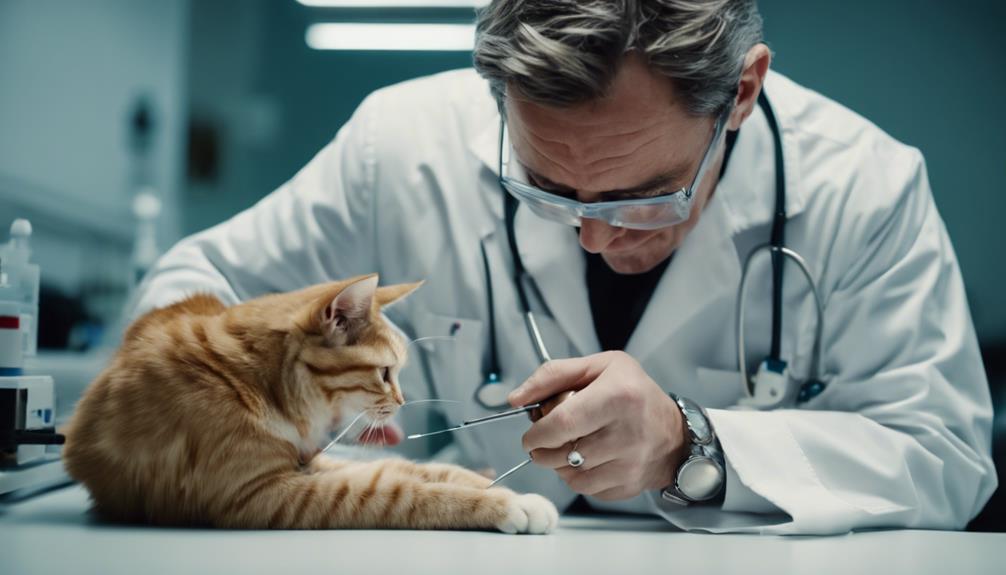
Periodically monitoring the health of cats through comprehensive veterinary examinations is crucial for uncovering potential hidden illnesses that may go unnoticed by pet owners.
Ways to Detect Hidden Illnesses in Cats:
- Blood Tests: Screening for organ function and diseases.
- Urinalysis: Checking for signs of infection or kidney issues.
- X-rays: Revealing hidden tumors, fractures, or obstructions.
- Ultrasounds: Identifying internal abnormalities like tumors or fluid buildup.
These diagnostic tools help veterinarians catch underlying health issues early, allowing for prompt treatment and better outcomes for our feline companions. Regular veterinary checkups play a vital role in ensuring the well-being of our beloved cats.
Frequency of Checkups for Cats
Ensuring the optimal health of feline companions necessitates adherence to a structured schedule of veterinary checkups. Regular checkups are crucial to monitoring your cat's well-being as they age.
Adult cats should ideally have a comprehensive examination at least once a year. For senior cats, those aged seven and older, bi-annual visits every six months are recommended due to their increased susceptibility to age-related conditions.
Cats with chronic health issues may require more frequent check-ins to manage their conditions effectively.
Preparation for Vet Visit
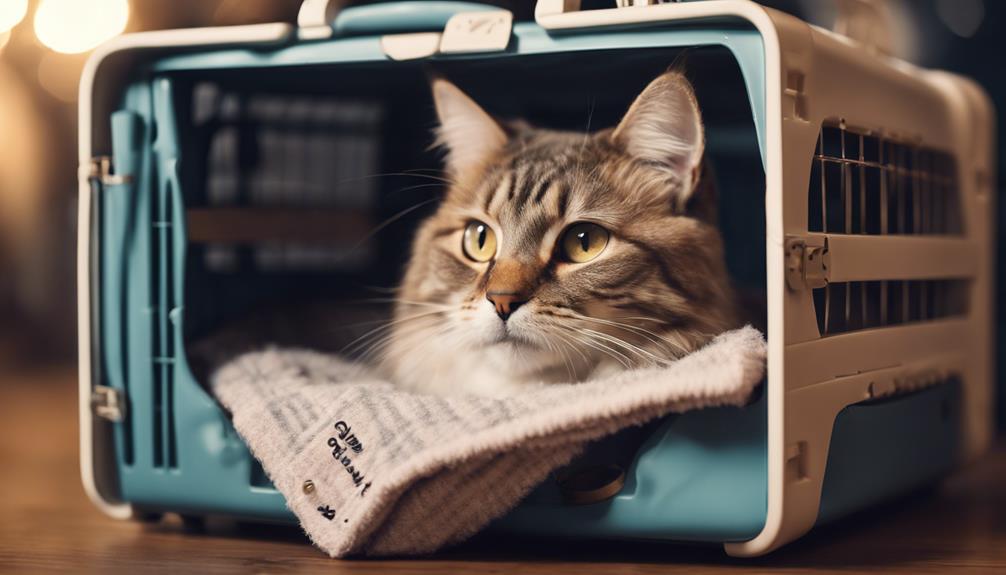
To ensure your cat's veterinary visit goes smoothly and effectively, thorough preparation beforehand is key to optimizing the examination process and your cat's overall well-being.
Preparation Tips for Your Cat's Vet Visit:
- Use Calming Aids: Consider using products like Feliway to help relax your cat.
- Secure Transportation: Safely transport your cat in a carrier or on a harness.
- Bring Essential Information: Prepare a list of questions, diet details, medications, and vet records.
- Provide a Stool Sample: If possible, bring a fresh stool sample for examination.
Using Calming Aids for Cats
Using calming aids for cats can help alleviate stress and anxiety during veterinary visits and other potentially anxiety-inducing situations. Cats are known for their sensitivity to changes in their environment, which can lead to heightened levels of stress.
Calming aids such as pheromone products like Feliway or natural supplements can help ease your cat's nerves and promote a sense of calmness. These aids can be particularly beneficial for cats who get anxious during car rides or when visiting the veterinarian.
Secure Cat Transportation
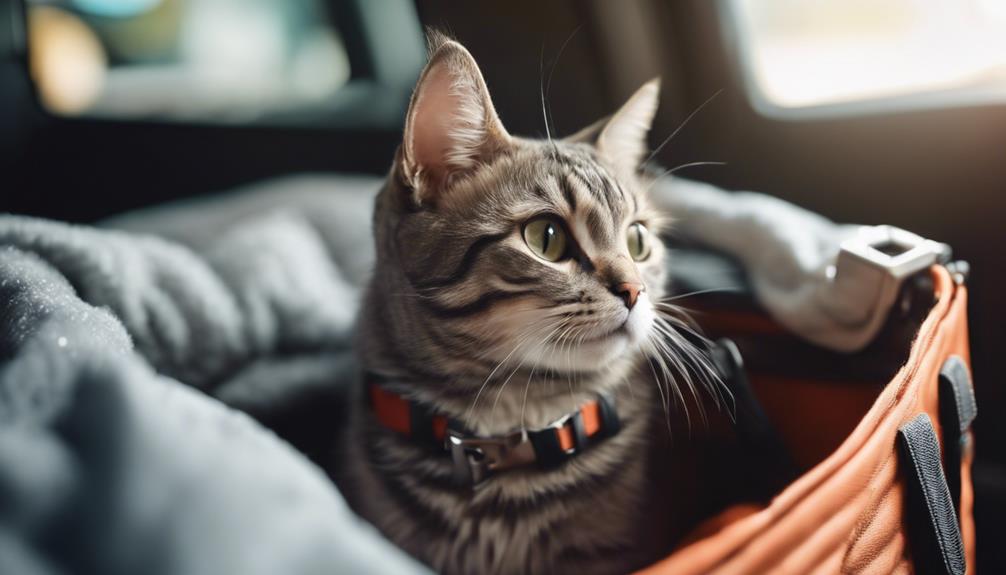
When transporting your cat securely, it is crucial to prioritize their safety and comfort above all else.
Tips for Secure Cat Transportation:
1) Choose a comfortable carrier: Opt for a carrier that is well-ventilated and spacious enough for your cat to stand, turn around, and lie down comfortably.
2) Secure the carrier: Ensure the carrier is properly secured in the vehicle to prevent sliding or tipping during transportation.
3) Cover the carrier: Covering the carrier with a light blanket can help reduce stress by providing a cozy and secure environment.
4) Avoid sudden movements: Drive smoothly and avoid sudden stops or sharp turns to keep your cat calm during the journey.
Items to Bring to the Visit
Prior to your cat's annual vet visit, ensure you bring along essential items to facilitate a thorough examination and address any potential health concerns. It is advisable to carry a list of questions regarding your cat's behavior, diet, and any observed changes.
Include information about current medications, supplements, or treatments your cat is receiving. Bringing your cat's medical history and vaccination records can help the vet understand your cat's health background better.
Additionally, if possible, provide a fresh stool sample for examination. These items will aid the vet in providing comprehensive care and addressing any specific issues your cat may be facing.
Being prepared with these essentials can contribute to a productive and beneficial vet visit for your beloved feline companion.
Components of Wellness Exam
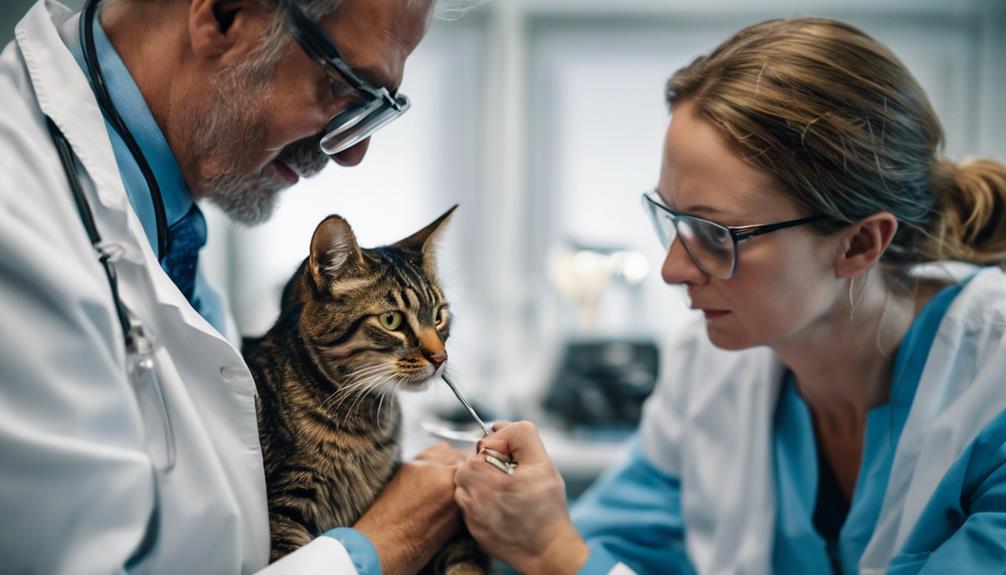
The examination during a cat's wellness visit encompasses a thorough evaluation of the feline's overall health, from head to tail, conducted by a veterinarian.
- Head-to-Tail Evaluation: Veterinarians meticulously examine every aspect of your cat, starting from the head and progressing down to the tail.
- Observation, Palpation, Auscultation: This comprehensive physical exam involves observing your cat's demeanor, feeling for any abnormalities, and listening to internal sounds.
- Vital Signs Check: Body temperature, heart rate, and respiratory rate are carefully assessed to gauge your cat's overall health.
- Early Detection: By keenly observing your cat, veterinarians can detect subtle signs of illness before they escalate.
Detailed Physical Examination
Conducting a thorough physical examination during a cat's wellness visit involves a meticulous evaluation of the feline's overall health, encompassing observations from head to tail. The veterinarian carefully inspects the cat's overall appearance for any abnormalities, assessing body condition, consciousness, gait, and hydration levels.
Specific areas such as the head and neck are examined for asymmetry, lumps, or dental issues. The body and limbs are checked for any growths, signs of arthritis, or skin conditions. Furthermore, a detailed examination of the heart, lungs, abdomen, and genital area is conducted to ensure a comprehensive assessment of the cat's health.
This detailed physical examination is essential in identifying any potential health concerns and ensuring the well-being of the cat.
Observations for Early Detection
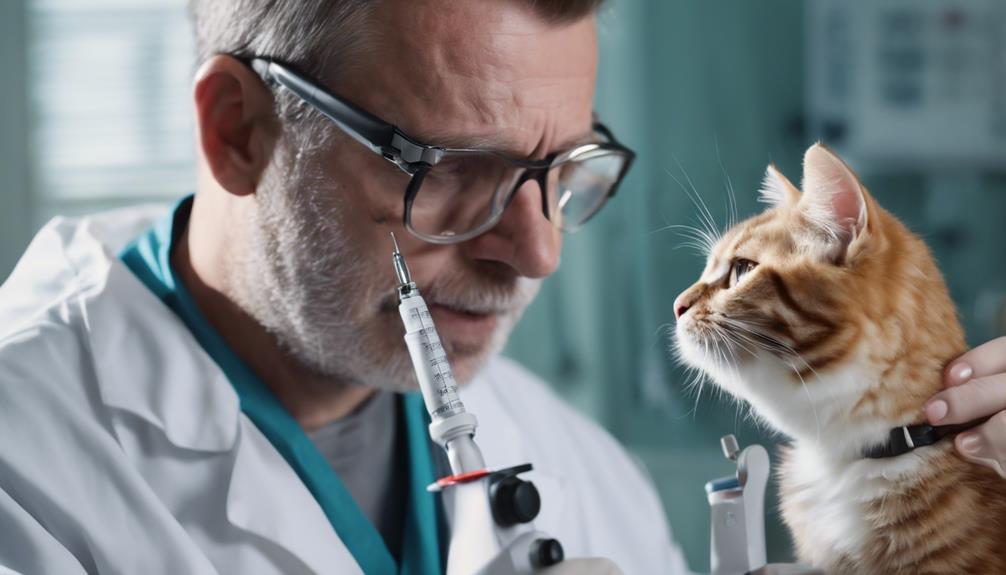
During a cat's wellness visit, keen observations play a crucial role in early detection of potential health issues.
- 1. Behavioral Changes: Note any shifts in activity levels or appetite.
- 2. Coat and Skin: Look for lumps, bumps, or changes in fur texture.
- 3. Eye and Ear Health: Check for redness, discharge, or abnormal odors.
- 4. Weight Management: Monitor weight fluctuations as sudden changes can indicate underlying problems.
These observations, coupled with a thorough physical examination, help veterinarians identify issues early on, leading to better outcomes for your feline companion.
Paying attention to these details can provide valuable insights into your cat's health status and ensure they receive timely care.
Evaluation of Body Condition
Assessing a cat's body condition plays a vital role in evaluating its overall health and well-being.
During the wellness visit, the veterinarian will carefully assess your cat's body composition, muscle tone, and weight distribution.
A cat's body condition score helps determine if it is underweight, overweight, or at an ideal weight for its size and breed.
By evaluating body condition, the vet can identify potential health issues such as obesity, malnutrition, or muscle loss.
Maintaining an optimal body condition is crucial for your cat's overall health and quality of life.
The vet may provide dietary recommendations or suggest exercise routines to help your cat achieve and maintain a healthy body condition.
Examination of Head and Neck
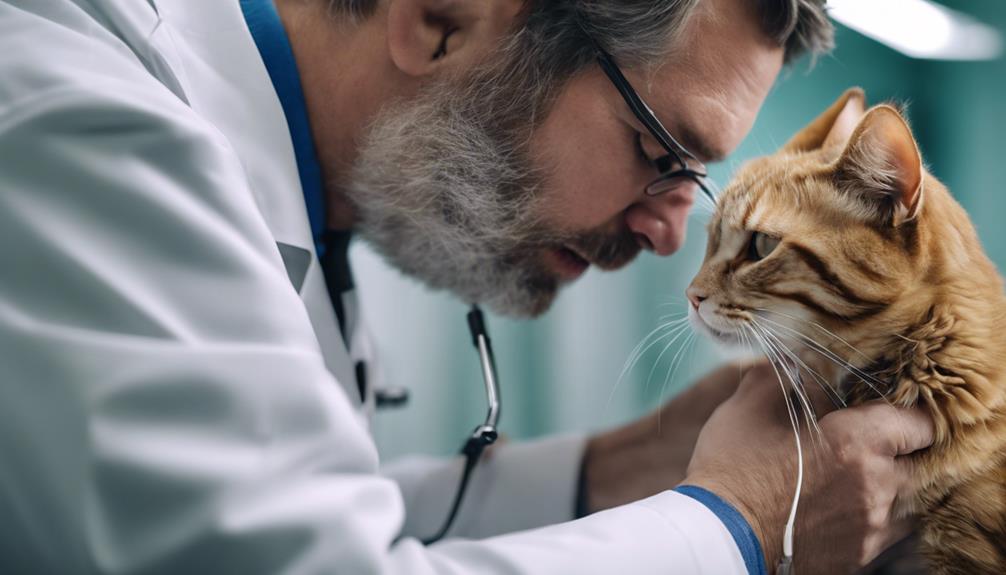
The initial phase of the veterinary wellness exam for cats involves a thorough examination of the head and neck region. This critical step allows the vet to assess various aspects of your cat's health in detail. Here are four key elements of the head and neck examination:
- Observation: The vet will visually inspect the head and neck for any signs of abnormalities.
- Palpation: By gently feeling around the head and neck, the vet can detect any lumps, bumps, or areas of tenderness.
- Dental Evaluation: Checking the teeth and gums is crucial for overall health, as dental issues can impact your cat's well-being.
- Lymph Node Assessment: Feeling for any enlarged lymph nodes can provide valuable insights into your cat's immune system and general health.
Thorough Body and Limb Check
Moving on from the detailed examination of the head and neck region, the veterinary wellness exam for cats progresses towards a thorough assessment of the body and limbs. During this part of the exam, the veterinarian carefully inspects your cat's body for any abnormalities, growths, or skin conditions. They also check the limbs for signs of arthritis, injuries, or pain. A 3×3 table is presented below to highlight the key aspects of the body and limb check:
| Body and Limb Check | What is Checked | Purpose |
|---|---|---|
| Overall appearance | Abnormalities | Detecting signs of illness |
| Body condition | Consciousness | Evaluating overall health |
| Gait and hydration | Growth, arthritis | Assessing mobility |
Examination of Vital Areas
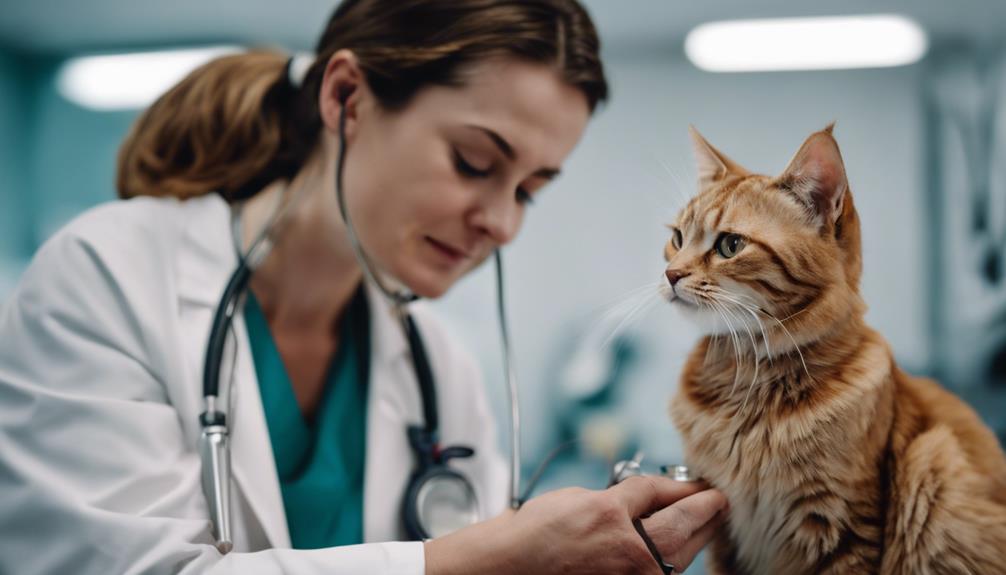
During the examination of vital areas in a cat's wellness visit, a comprehensive assessment is conducted to evaluate key internal systems and organs.
- Heart and Lungs: The veterinarian listens for any abnormal sounds that could indicate heart or respiratory issues.
- Abdomen: Palpation is performed to check for any abnormalities in the organs such as the liver, kidneys, and intestines.
- Genital Area: The vet examines for any signs of infections, tumors, or other issues in this sensitive region.
- Lymph Nodes: These small, bean-shaped structures are checked for any swelling, which could be a sign of infection or disease.
This thorough examination helps ensure that your cat's vital areas are in good health, providing you with peace of mind regarding your feline companion's well-being.
Frequently Asked Questions
Can I Request a Specific Veterinarian for My Cat's Annual Vet Visit?
Yes, you can request a specific veterinarian for your cat's annual vet visit. It's important to communicate this preference in advance to ensure continuity of care and familiarity. Building a relationship with a trusted vet enhances your cat's well-being.
Are There Any Discounts or Wellness Packages Available for Multiple Cats in a Household?
Discounts and wellness packages for multiple cats in a household vary by veterinary clinics. Inquire about bundled services, like vaccinations or exams, for cost-effective options. Some establishments offer reduced rates for multiple pets, promoting comprehensive care for all feline companions.
How Often Should I Update My Cat's Medical Records With the Vet?
Updating your cat's medical records with the vet should occur with every visit. Regular updates ensure accurate documentation of your cat's health history, treatments, and vaccinations, aiding in comprehensive care and quick reference during emergencies or consultations.
Can the Vet Provide Recommendations for At-Home Dental Care for My Cat?
The vet can provide recommendations for at-home dental care for your cat. They may suggest tooth brushing, dental treats, water additives, or dental diets. Regular dental care can prevent oral health issues and maintain your cat's overall well-being.
Are There Any Specific Dietary Recommendations for Senior Cats During Their Wellness Exams?
During senior cat wellness exams, specific dietary recommendations may be suggested based on individual health needs such as joint support, weight management, or kidney function. Adjustments to protein, fat, fiber, and supplements can benefit aging felines.
How Does Understanding Cat Dental Anatomy Help During Annual Vet Visits?
Understanding cat dental anatomy, including the cat teeth functions unveiled, is crucial during annual vet visits. It allows the veterinarian to assess the overall oral health of the cat, identify any potential issues, and provide necessary dental care. A thorough understanding of cat dental anatomy ensures proactive and effective dental treatment for the feline.
Conclusion
In conclusion, annual veterinary visits for cats are crucial for maintaining their health and well-being. These routine check-ups aid in the early detection of potential health concerns and ensure comprehensive care for our feline companions.
Understanding the significance of these visits and the thorough preparations involved can enhance the effectiveness of the veterinary consultation, ultimately contributing to the overall health and longevity of our beloved cats.




